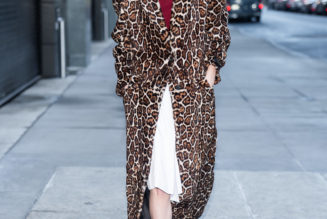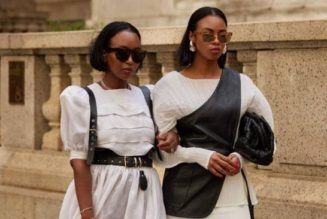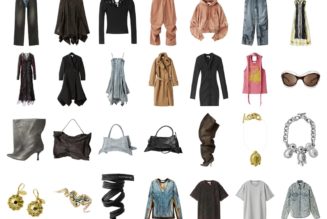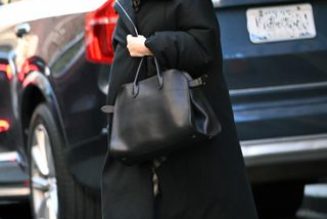
It’s all about the pictures. The models have the severe features and slicked-back hair you’d see on the runway of a designer European sportswear house. One strides down a yellow catwalk in a white linen and cotton sweater that buttons off to the side, with an appealingly floppy collar, and a pair of polished cargo pants. She looks chic — rich, even! On her shoulder is a leather bag wrapped with belt-like straps. It’s a great bag. The look is effortless, luxurious and above all, that elusive thing, stylish.
Who is the designer? The understated Italian craftsmanship of Bottega Veneta? The brainy-sexy moodiness of Khaite? The kooky minimalism of the Row?
Try something closer to the food court: It’s Zara.
As fast fashion has gotten quicker and cheaper — and European luxury companies have started commanding outrageous prices — the mall and e-commerce stalwart Zara, which was founded in Spain in 1975, is upscaling its image. Not only is it raising prices and sharpening its product, but it has drawn in some of the biggest talent in the fashion industry — the kind of people who work for the brands that Zara has long been accused of knocking off.
The aforementioned images, which are part of Zara’s latest SRPLS collection, were creative directed by Karl Templer, the stylist behind decades of moody and strange fashion images, and photographed by Craig McDean, known for his kinetic, minimalist snaps of models such as Stella Tennant and Kate Moss for Harper’s Bazaar and Vogue Italia. (SRPLS, whose aim, per its Instagram, “is to upgrade the utilitarian,” is one of Zara’s dizzying number of collections, including Studio and Basics.)
But unlike the four- and five-figure price tags featured in magazine images, the sweater is $139. The pants: $129. The bag? $139. And it’s real leather.
“I treat every fashion brand the same,” McDean said in a recent phone interview. He’s done countless campaigns and photoshoots with Templer and Fabien Baron, another Zara collaborator, known for revitalizing Harper’s Bazaar, French and Italian Vogue and Interview, as well as labels such as Calvin Klein and Balenciaga under his agency Baron & Baron. “To be totally honest, it’s almost like [being] back in the family again.”
“The evolution has been from good taste neutralism,” said Templer, to “almost like going to an amazing department store and you find all kinds of sub-collections.”
Mishmashes between designer luxury and low-price labels hardly raise an eyebrow these days. The elusive avant-gardist Martin Margiela remade his hit pieces for H&M more than a decade ago, and Simone Rocha did the same three years ago. Target has churned out budget collections by Proenza Schouler and Diane von Furstenberg for 20 years. But rarely is the talent associated with the industry’s most elevated clothing and image-making embedded so firmly into fast fashion. Usually, that kind of talent, expensive and picky about whom they collaborate with, is reserved for special projects or collaborations, with their names proudly slapped on the campaign imagery.
Mall or fast-fashion businesses — including Zara — are known for emulating the images and products of European luxury houses — not competing with them.
But there seems to be no stigma around fast fashion for luxury’s old guard. The supermodel Linda Evangelista posed for a capsule collection designed by photographer Steven Meisel and wears Zara regularly. “There’s no shame in it — there’s pride in it,” she said. “It’s not, ‘Oh I have Zara today, let me bang it out.’ There’s effort that goes into it.”
In fact, most of the collaborators don’t think of Zara as fast fashion at all. “Zara is a designer brand now,” said Guido Palau, who does hair for Prada and Valentino shows, while sitting in an enormous box plopped in front of the Pompidou during Paris Fashion Week in early March. He was there to launch a line of Zara hair products, which he developed but which did not feature his name emblazoned on the colorful, Memphis Design-esque bottles designed by Baron. “They’re really giving their customers a high-end product.”
Zara’s transformation began as many luxury brand reorganizations do: in the family. In 2022, 40-year-old Marta Ortega Pérez, the youngest child of Zara founder Amancio Ortega, became the chairperson of Inditex, which owns Zara. Inditex has a number of other brands, most notably Massimo Dutti — though Zara (and Zara Home) represent 72 percent of its profits.
Ortega, like the children of LVMH boss Bernard Arnault, seems invested in improving the giant her father created. She has worked at Zara since she graduated from business school at Regent’s University London, in various roles, including on the sales floor and in the women’s design and product development team. She is a regular presence at Paris Fashion Week, almost always dressed in Inditex designs.
It is Ortega, Zara’s collaborators say, who has led the shift upward. When Narciso Rodriguez, who designed Carolyn Bessette’s wedding dress, decided to shut down his atelier in the midst of the pandemic, it was Ortega who suggested he make a capsule of his archival hits for Zara. Ortega was the one who called up Baron. Even Evangelista is on a first-name basis with Ortega: “Marta — she’s a genius. She knows what she’s doing.”
Ortega, as a rule, does not grant interviews, and her coyness has even fazed investors. (That reticence, incidentally, is also quite high fashion, as top-tier creatives and businesspeople are known for their terseness.)
But her few available words speak to her ambitions for her family’s business: “We don’t want to be fast; we want to be agile and flexible,” she wrote in Inditex’s 2022 annual report. “We don’t want to be big, we want to be relevant. We want to be agents of change and aspire to lead our industry’s transformation. We want to have a positive impact in everything we do.”
In 2022, the company posted record numbers. Sales rose another 10 percent in the last year, bringing Zara’s sales to $39 billion as of January 2023. That puts it far behind LVMH’s $80-plus billion in 2023 revenue, but that growth is in the midst of a luxury slowdown that has led to a steep drop in Kering’s profits so far this year. But cheaper and faster competitors like Shein are gaining ground, with some estimating Shein may have brought in more than $30 billion in 2023.
In the mid-2000s, shopping at Zara was a bragging right for fashion insiders, who found its pieces the perfect complement to Phoebe Philo’s Celine minimalism and Hedi Slimane’s slick Saint Laurent designs — a look that became known as the high-low mix.
Kim France, the founding editor of the now-folded shopping magazine Lucky, recalled saying: “There are two great moments in a woman’s shopping life: one is when she gets complimented for something and she can say, ‘Oh, it’s Chanel!’ And the other time is when she can say, ‘Oh, it’s Zara!’” The Zara compliment was the greater one, France said. “The high-low mix came from a place of wanting to be creative with how you dress.”
But by the mid-2010s, increased attention on the ethics of fast fashion cast a pall over Zara. “Even designer collections are forced to adopt an industrial pace and scale … [to] compete against fast-fashion behemoths like Zara and H&M,” Dana Thomas quoted French couturier Jean Paul Gaultier as saying in her 2019 book “Fashionopolis,” an investigation into fast fashion. (The fact that Melania Trump’s infamous “I really don’t care, do u?” Zara jacket worn during a 2018 visit to a Texas migrant detention center did not help matters, either.)
And luxury houses began producing more-accessible, less-expensive products, such as sneakers, slide sandals and sweatshirts that fueled a global boom in luxury spending, especially through the pandemic. Consumers began applying the behaviors they developed shopping at fast fashion labels — buying a lot of stuff, and wearing it just a few times — to all of their purchases.
“Fast-fashion behaviors are not limited to fast-fashion brands,” said Mark Sumner, a lecturer at the University of Leeds who focuses on fashion sustainability. “I have spoken to various luxury brands who will talk about a customer that in reality is a fast-fashion customer. They buy stuff, they might wear it, they might not wear it. And if they do wear that, might wear it three or four times, and then they go out and buy a replacement almost immediately.”
Zara has tried to move away from its fast-fashion associations for years, setting aggressive targets in 2019 that would use, for example, sustainable, organic or recycled cotton, sustainable linen and recycled polyester by 2025 — and in fact, introduced new targets that its CEO called “extremely ambitious.”
Sumner was pleasantly surprised by the sustainability efforts outlined in Zara’s lengthy annual reports: “I’m not sure if there’s any brand that is moving fast enough, going far enough, to be able to alleviate my anxiety. So putting that to one side, where do we see good practice?” he said. Zara seems to be “recognizing that their responsibility as a business to the local communities, to their suppliers, to their stakeholders is actually as important as that drive for profitability.”
Zara’s evolution seems motivated by a desire to emphasize the difference between themselves and rivals, who are nipping at their heels — in both design and ethics.
While Zara has worked with top fashion talent such as Guido Palau and Pat McGrath for years, the change began in earnest when Ortega approached Baron seven years ago. “I said to myself, if I do something for Zara, it’s to show that it can be absolutely amazing looking, and absolutely beautiful, and very sophisticated and very high end, and that’s what I said to Marta — that’s what I’d like to do. I’d like to bring great photographers to you, great team of people who will do a really good job and make the work standout.” He called up Meisel and Templer.
From there, more high-fashion figures entered the fold and their responsibilities grew. While nearly 300 designers work with Zara, Ortega, at the suggestion of Meisel, enlisted Templer to weigh in on the clothes, including its Studio line, which offers more sophisticated, complex stuff: a camel-colored belted leather trench coat for $699, say, or slouchy leather boots for $299.
“Normally fashion works through slight exaggeration, so you try to exaggerate whatever is of the moment,” Templer said. He might suggest that a shoulder should be a bit bigger or that shoes should have a round toe rather than a pointy one. Maybe a heel should be sculptural metal instead of leather, or a jacket should have buttons that are two sizes too big. These are the kinds of slightly unpragmatic ideas that, in shorthand, turn clothes into fashion. After the collection is done, he said, he styles the images by suggesting “perhaps the model should be a bit more athletic, or perhaps have shorter hair.”
Collaborators claim this has moved them away from their reputation for knockoffs. “They work with great fabrics, with great suppliers,” Baron said. “They have access to the same fabrics that a [luxury] designer would take. They are able to make the price more affordable because of the amount [of product they produce], which makes sense, right?”
Rodriguez, whose collection of archival re-creations was released in September 2022, said that Zara used the materials he employed for his original designs, sourced from the same mills. Asked whether the Zara pieces were different from the ones he made in his New York atelier, he said, “I honestly cannot think of one thing that I remember straying from my original pattern.”
Evangelista said that, in addition to the pieces she was gifted from a 2023 collaboration with Meisel, she bought several more: “There were so many good things in that collection!” She even has Zara hunt down pieces for her in other parts of the world if they’ve sold out in the United States.
She also finds it appealing because of the prices of traditional luxury houses, which she said have gotten “not attainable.” “I can have a few leather jackets this season if I get them from Zara,” she said. “And if I get them from — I’m not going to name designers — I might not buy it! Because two of their jackets is [the price of] a car.”
If the woman who once said she wouldn’t get out of bed for less than $10,000 a day is wondering if high-end fashion has gotten too pricey, you know something has changed.
In the 1990s and early 2000s, fashion magazines, especially Harper’s Bazaar, under Liz Tilberis, and Italian Vogue, then edited by Franca Sozzani, as well as the Face, Another, i-D and Dazed & Confused, were renowned for the kind of provocative, even enthralling photographs that Vince Aletti, in “Issues,” his 2019 history of fashion magazines, called “sexy souvenir[s] of the culture wars.”
Now these publications have younger, digitally native editors, and the influence of the fashion image, not to mention the multi-spread editorials with extravagant budgets, has faded.
While many of these Zara collaborators still work with fashion magazines — Meisel, for example, shot many of former British Vogue editor Edward Enninful’s covers — imagery tends to be more subdued, and carefully reviewed, especially following #MeToo. (In 2018, Templer was named in a Boston Globe investigation into the exploitation of models, allegations he denied in a letter published a week later in WWD.)
Baron pointed out that Zara, unlike the brands with which it hopes to compete, does not do runway shows or traditional ad campaigns in airports or magazines. Its e-commerce imagery is its only channel for communication.
So eccentric are some of Zara’s images that an Instagram account, AwkwardZara, catalogues the strange poses and angles of their e-commerce photographs. But these images won’t look so alien to people who grew up admiring the images of Juergen Teller, the comic severity of Meisel photographs or the emotive postures of McDean’s work.
Zara “allows you the creative freedom,” said McDean, “whereas sometimes, you’re not so free with a lot of other brands.”
Evangelista agreed. “If only editors in chief could be like that and understand that when … you’re imposing ideas on the work, and [saying], I need it like this, I need it like that — it’s a compromise. And then you wonder why it’s not their best work.”
Those are spicy for the magazine world. But perhaps even more dangerous for the big business of inexpensive clothes.









